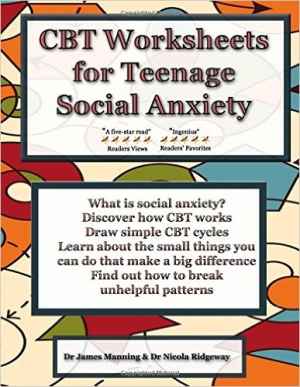
CBT Worksheets for Teenage Social Anxiety
Though the book is geared to teens, adults suffering from social anxiety will also find it helpful.
In CBT Worksheets for Teenage Social Anxiety, clinical psychologists James Manning and Nicola Ridgeway offer timely help for adolescents whose extreme shyness and self-consciousness inhibit development and the formation of normal social relationships.
Though the title refers only to worksheets, this is much more than a blank book or journal, and functions effectively as a guide to anxiety, an introduction to CBT (cognitive behavioral therapy), and a guided, interactive workbook for recovery.
The work begins with an explanation of social anxiety and a short course on how beliefs, experiences, and brain chemistry interact to affect both thoughts and actions. It explains how these processes can be redirected with CBT, a nondrug therapy that identifies the negative beliefs and thoughts that lead to the harmful behaviors and ultimately reinforce negative thoughts. The book then slides gracefully into an initial exercise that helps readers to recognize their own dysfunctional behaviors. An early mark of the book’s consistent expertise is that it does not present a mere checklist, but asks its readers to write down each behavior, thus making exercises much more personal and increasing the level of commitment.
Using this information-and-exercise format as a template, the book goes on to build its readers’ powers of self-observation so that they can understand negative thoughts and acts and, ultimately, develop the ability to replace them with realistic thoughts, responses, positive actions, and the emotional resilience to promote social adjustment. Learning that social anxiety is not an intractable personality flaw, but is rather the outcome of factors that can be understood and controlled, is in itself freeing, and exercises that help readers to identify negative cycles, set positive goals, and cope with setbacks will help to build confidence.
The tone throughout the book is just right, neither too technical nor condescending. In explaining brain function, for example, “neo-cortex,” “pre-frontal cortex,” and “sub-cortical region” are replaced with the more connotative and easily-remembered “brainy part,” “minder,” and “animal part.” Similarly, “dysfunctional behaviors” are understood as anxiety-buffering “safety behaviors.” Diagrams help readers see how belief-behavior cycles—both positive and negative—work, and the inclusion of dialogues, suggested alternative behaviors, and examples drawn from therapy give the book a friendly and nonjudgmental feel.
While the authors recommend therapy as an adjunct to the book, adolescents who are resistant to seeing a therapist or who don’t have access to one can use the book on its own. And though the book is geared to teens, adults suffering from social anxiety will also find it helpful. This is an outstanding entry in the self-help field.
Reviewed by
Susan Waggoner
Disclosure: This article is not an endorsement, but a review. The publisher of this book provided free copies of the book and paid a small fee to have their book reviewed by a professional reviewer. Foreword Reviews and Clarion Reviews make no guarantee that the publisher will receive a positive review. Foreword Magazine, Inc. is disclosing this in accordance with the Federal Trade Commission’s 16 CFR, Part 255.
